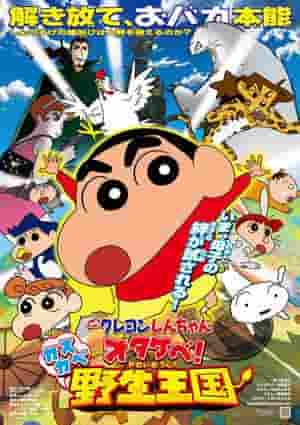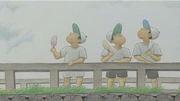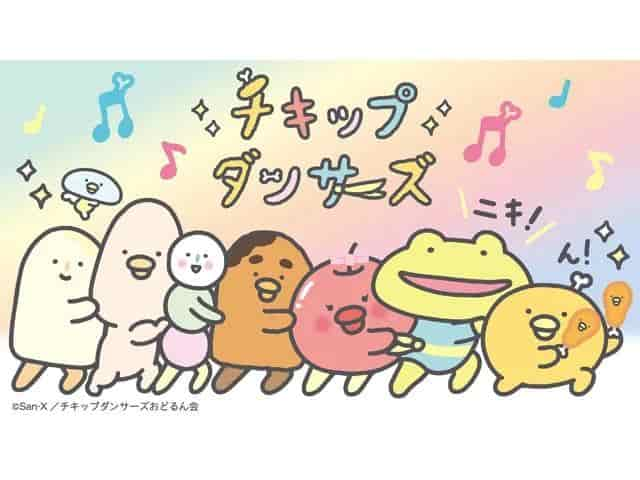Crayon Shin-chan: Otakebe! Kasukabe Wild Kingdom - The appeal and reviews of the 17th movie

Crayon Shin-chan: Otakebe! Kasukabe Wild Kingdom - Movie reviews and detailsOverviewCrayon Shin-chan: Otakebe! Kasukabe Wild Kingdom is an animated feature film based on Yoshito Usui's popular manga Crayon Shin-chan, the 17th film in the series. It was released on April 18, 2009 and distributed by Toho. It is directed by Akira Shigino and produced by Shin-Ei Animation, TV Asahi, ADK, and Futabasha. The 96-minute film follows the adventures of Shinnosuke Nohara and his family as they tackle radical ecological activism. ■ StoryIn the town of Kasukabe, ecological activities that are kind to the earth are becoming more and more popular. One day, Hiroshi and Misae drink a mysterious drink that Shinnosuke finds while picking up trash. The two suddenly transform into animals. This is part of a "human animalization plan" that is being carried out in secret by the radical eco-organization "Sukebbe." Once transformed into an animal, one loses their memories of being human, so Shinnosuke struggles to return Hiroshi and Misae to their original forms and to crush Sukebbe's ambitions. Shinnosuke's roar will now reverberate around the world. ■ExplanationCrayon Shin-chan: Otakebe! Kasukabe Wild Kingdom is a work that skillfully combines the series' traditional humor with social satire. While taking up the important theme of ecology in modern society, the story depicts Shinnosuke's innocence and love for his family, making it enjoyable for both children and adults. In particular, the scene in which Hiroshi and Misae are transformed into animals and Shinnosuke's struggle are very visually impactful. In addition, the existence of an organization called Sukebe suggests the dangers of extreme ecological activities, and a deeper message is conveyed. ■CastThe cast of this work includes familiar voice actors from the series. Acting that brings out the best in the characters' personalities is outstanding, such as Yajima Akiko as Nohara Shinnosuke, Narahashi Miki as Nohara Misae, Fujiwara Keiji as Nohara Hiroshi, and Koorogi Satomi as Nohara Himawari. There is also a strong supporting cast, including Mashiba Mari as Shiro and Kazama-kun, Hayashi Tamao as Nene-chan, Ichiryusai Sadatomo as Masao-kun, and Sato Chie as Bo-chan. In addition, new characters such as Goto Yuko as Victoria, Yamamoto Takahiro as Bunbetsu, and Orikasa Ai as Maihashi are also portrayed with great charm. ■ Main staffDirector Shigino Akira has perfectly balanced the humor and emotion that characterize the series, maximizing the visual impact. Screenwriter Shizuya Isao has constructed a story that can be enjoyed by children and adults alike by depicting Shinnosuke's adventures while skillfully incorporating the theme of ecology. Animation directors Hara Katsunori and Hariganeya Hideo, and character designers Hara Katsunori and Sueyoshi Yuichiro have drawn the characters' movements and expressions with great attention to detail. Art directors Morio Maki and Nishimura Takashi, color designer Nonaka Sachiko, cinematographer Umeda Toshiyuki, editor Kojima Toshihiko, and other staff members have worked together to improve the quality of the work. Additionally, the sound aspect has been highly praised, with sound director Okuma Akira and music composers Wakakusa Megumi, Arakawa Toshiyuki, and Maruo Minoru. ■ Main CharactersNohara Shinnosuke is the most troublesome 5-year-old boy in Japan, and he loves beautiful older women and Chocobi sweets. He often causes trouble for adults with his silly behavior, but only Misae can stop him. Nohara Misae is Shinnosuke's mother, and she often fails at dieting and is often teased about her big butt. There are three sisters: Musae, an aspiring photographer, and Masae, an older sister. Nohara Himawari is Shinnosuke's younger sister, and even though she is just an infant, she loves handsome men and shiny things. Nohara Hiroshi is Shinnosuke's father, and is the section chief of the second division of the sales department at Futaba Shoji. Shin-chan's love of older women may be the result of his upbringing. Shiro is the Nohara family's pet, and may be the most reliable member of the family. The members of the Kasukabe Defense Force also play important roles. Masao-kun is timid and prone to mistakes, and dreams of becoming a manga artist. Kazama-kun has wisdom and confidence that is hard to believe for a kindergartener. Nene-chan is a precocious girl who takes out her anger on her stuffed animals. Bo-chan is quiet and absent-minded, but can be relied upon in times of crisis. The teachers at Futaba Kindergarten also add color to the story. The principal looks intimidating, but is a kind person. Yoshinaga-sensei is the homeroom teacher for Shinnosuke and his friends. Matsuzaka-sensei is a high-spirited, aggressive teacher who often clashes with Yoshinaga-sensei. Ageo-sensei is easygoing and does things at her own pace, but sometimes shows her true colors. ■ Related worksCrayon Shin-chan: Otakebe! Kasukabe Wild Kingdom is closely related to the TV series Crayon Shin-chan. The TV series depicts Shinnosuke's daily life and interactions with his family, while the film shows the characters embarking on new adventures. By watching the TV series, you can gain a deeper understanding of the backgrounds and relationships of the characters in the film. ■ Theme songs and musicThe opening theme "Yuru Yuru de DE-O!" was written by Muto Yuji, composed by Nakamura Yasunari, arranged by Iwasaki Takafumi, and sung by Yajima Akiko, who plays Nohara Shinnosuke. This song symbolizes Shinnosuke's innocence and humor, and enhances the atmosphere of the movie. The ending theme "Yancha Michi" was written and composed by Nakamura Ataru, arranged by Suzuki Go, and sung by Jero. This song symbolizes Shinnosuke's adventure and growth, and enhances the emotion of the movie. ■ReviewCrayon Shin-chan: Otakebe! Kasukabe Wild Kingdom is a work that skillfully combines the series' traditional humor with social satire. While taking up the important theme of ecology in modern society, the story depicts Shinnosuke's innocence and love for his family, making it enjoyable for both children and adults. In particular, the scene in which Hiroshi and Misae are transformed into animals and Shinnosuke's struggle are very visually impactful. In addition, the existence of an organization called Sukebe suggests the dangers of extreme ecological activities, and a deeper message is conveyed. The acting of the cast is also excellent, especially Yajima Akiko as Nohara Shinnosuke, Narahashi Miki as Nohara Misae, Fujiwara Keiji as Nohara Hiroshi, and Koorogi Satomi as Nohara Himawari, who bring out the best in their characters' personalities. In addition, the supporting cast is also excellent, including Mashiba Mari as Shiro and Kazama-kun, Hayashi Tamao as Nene-chan, Ichiryusai Sadatomo as Masao-kun, and Sato Chie as Bo-chan. Furthermore, new characters such as Goto Yuko as Victoria, Yamamoto Takahiro as Bunbetsu, and Orikasa Ai as Maihashi are also charmingly portrayed. Director Shigino Akira has perfectly balanced the humor and emotion that characterize the series, maximizing the visual impact. Screenwriter Shizuya Isao has constructed a story that can be enjoyed by children and adults alike by depicting Shinnosuke's adventures while skillfully incorporating the theme of ecology. Animation directors Hara Katsunori and Hariganeya Hideo, and character designers Hara Katsunori and Sueyoshi Yuichiro have drawn the characters' movements and expressions with great attention to detail. Art directors Morio Maki and Nishimura Takashi, color designer Nonaka Sachiko, cinematographer Umeda Toshiyuki, editor Kojima Toshihiko, and other staff members have worked together to improve the quality of the work. Additionally, the sound aspect has been highly praised, with sound director Okuma Akira and music composers Wakakusa Megumi, Arakawa Toshiyuki, and Maruo Minoru. The opening theme "Yuru Yuru de DE-O!" and the ending theme "Yancha Michi" are also important elements that liven up the atmosphere of the movie. The opening theme is a song that symbolizes Shinnosuke's innocence and humor, while the ending theme is a song that symbolizes Shinnosuke's adventure and growth. These songs enhance the moving feeling of the movie. "Crayon Shin-chan: Otakebe! Kasukabe Wild Kingdom" is a work that can be recommended not only to fans of the series, but also to those who are watching Crayon Shin-chan for the first time. This work depicts the importance of family love and friendship through the theme of ecology, and is enjoyable for children and adults alike. Please enjoy Shinnosuke's adventures at the theater or on DVD or Blu-ray. |
>>: The definitive comedy!? A thorough evaluation of Undersea Tangerine Peel Miles!
Recommend
The trailer of the movie "Mulan" topped the Weibo hot search list. Is it okay if Mushu is not included?
Disney released the first trailer of the live-act...
"A Quiet Place 2" grossed over 100 million yuan in China in just 4 days
The thriller "A Quiet Place 2" was rele...
"Macross Delta" Movie Review: What is the appeal of Passionate Walküre?
"Macross Delta: Passionate Walküre": A ...
Louis Koo's comedy "Wulin Monster" is scheduled for Christmas, and the East Factory's monster-catching spree causes controversy
Director Andrew Lau's new film "Wulin Mo...
The appeal and evaluation of "Kamukamo Shikamonidomo Kamo!": A new masterpiece of Minna no Uta
The appeal and evaluation of "Kamukamo Shika...
The appeal and reviews of "Pokonyan!": The perfect balance of relaxation and adventure
Pokonyan!: Fujiko F. Fujio's World of Love an...
Dune 2 will start filming in July next year and will be released in October 2023
"Dune 2" is scheduled to officially sta...
Donnie Yen bids farewell to Kung Fu movies and appoints Zhang Jin and Nicholas Tse to take over
According to Hong Kong media reports, Donnie Yen ...
The movie "Jiang Ziya" reveals dynamic scene concept map to reproduce the magnificent miracles on earth
Recently, the concept maps of the six major scene...
Review of "The Brave Fighter of Sun Fighbird": A story of a brave man's struggle and growth
The Brave Fighter of Sun Fighbird - The Brave Fig...
The Meg was rescheduled to be released in North America in August 2018 and was completed in January this year
According to foreign media reports, the Sino-US c...
The appeal and evaluation of Magical Girl Pretty Sammy: A deep look into the connection with the Tenchi Muyo! series
Magical Girl Pretty Sammy: A fusion of magic and ...
A thorough explanation of the appeal and evolution of BanG Dream! 2nd Season!
BanG Dream! 2nd Season - Detailed Review and Reco...
Nicolas Cage and Sono Sion's new film released on set
The thriller "Prisoners of Ghostland" d...
Louis Koo reveals: I had eight stitches on my right eyeball after getting injured while filming Dynasty Warriors
The movie "Dynasty Warriors" adapted fr...









